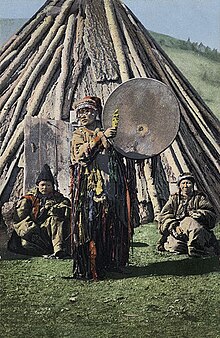腾格里 信仰

腾格![]() /tängri/;維吾
/tängri/;維吾
“腾格
腾格
腾格
参 见[编辑]
参考 文献 [编辑]
- ^ 1.0 1.1 Rona-Tas, Andras; András, Róna-Tas. Hungarians and Europe in the Early Middle Ages: An Introduction to Early Hungarian History. Central European University Press. 1999-03: 151 [2020-08-24]. ISBN 978-963-9116-48-1. (
原始 内容 存 档于2020-09-22) (英 语).There is no doubt that between the 6th and 9th centuries Tengrism was the religion among the nomads of the steppes
- ^ The spelling Tengrism is found in the 1960s, e.g. Bergounioux (ed.), Primitive and prehistoric religions, Volume 140, Hawthorn Books, 1966, p. 80. Tengrianism is a reflection of the Russian term, Тенгрианство. It is reported in 1996 ("so-called Tengrianism") in Shnirelʹman (ed.), Who gets the past?: competition for ancestors among non-Russian intellectuals in Russia, Woodrow Wilson Center Press, 1996, ISBN 978-0-8018-5221-3, p. 31 in the context of the nationalist rivalry over Bulgar legacy. The spellings Tengriism and Tengrianity are later, reported (deprecatingly, in scare quotes) in 2004 in Central Asiatic journal, vol. 48–49 (2004), p. 238. The Turkish term Tengricilik is also found from the 1990s. Mongolian Тэнгэр шүтлэг is used in a 1999 biography of Genghis Khan (Boldbaatar et. al, Чингис хаан, 1162-1227, Хаадын сан, 1999, p. 18).
- ^ R. Meserve, Religions in the central Asian environment. In: History of Civilizations of Central Asia, Volume IV (页面
存 档备份,存 于互联网档案 馆), The age of achievement: A.D. 750 to the end of the fifteenth century, Part Two: The achievements, p. 68:- "[...] The ‘imperial’ religion was more monotheistic, centred around the all-powerful god Tengri, the sky god."
- ^ Barbara Kellner-Heinkele; Brigitte Heuer; Elena V. Boykova. Man and Nature in the Altaic World. 2006 [2021-06-19]. (
原始 内容 存 档于2021-06-29). - ^ How to pronounce تەڭرى. [2021-06-19]. (
原始 内容 存 档于2021-06-28). - ^ Fergus, Michael; Jandosova, Janar. Kazakhstan: Coming of Age. Stacey International. 2003: 91 [2020-08-24]. ISBN 978-1-900988-61-2. (
原始 内容 存 档于2020-09-23) (英 语).[...] a profound combination of monotheism and polytheism that has come to be known as Tengrism.
- ^ Fodor István, A magyarok ősi vallásáról (About the old religion of the Hungarians) (页面
存 档备份,存 于互联网档案 馆) Vallástudományi Tanulmányok. 6/2004, Budapest, p. 17–19 - ^ McGuckin, John Anthony. The Encyclopedia of Eastern Orthodox Christianity. John Wiley & Sons. 2010-12-15: 79 [2020-08-24]. ISBN 978-1-4443-9254-8. (
原始 内容 存 档于2020-07-01) (英 语). - ^ 《汉书·
匈奴 传》:“匈奴 谓天为撑犁。” - ^ 《
册 府 元 龟·300》:“撑音田 庾切。” - ^ 《敕勒
歌 》:“天 苍苍,野 茫茫 ”。 - ^ Eröz, Mehmet. Eski Türk dini (gök tanrı inancı) ve Alevîlik-Bektaşilik. Türk Dünyası Araştırmaları Vakfı. 1992 [2020-08-24]. ISBN 978-975-498-051-6. (
原始 内容 存 档于2020-08-11) (土 耳 其语). - ^ Buddhist studies review, Volumes 6-8, 1989, p. 164.
- ^ Saunders, Robert A. and Vlad Strukov. Historical Dictionary of the Russian Federation. Lanham, MD: Scarecrow Press. 2010: 412–13. ISBN 978-0-81085475-8.
- ^ Saunders, Robert A.; Strukov, Vlad. Historical Dictionary of the Russian Federation. Scarecrow Press. 2010-05-13: 412–413 [2020-08-24]. ISBN 978-0-8108-7460-2. (
原始 内容 存 档于2020-09-13) (英 语). - ^ Balkanlar'dan Uluğ Türkistan'a Türk halk inançları Cilt 1, Yaşar Kalafat, Berikan, 2007
- ^ McDermott, Roger. High-Ranking Kyrgyz Official Proposes New National Ideology. The Jamestown Foundation. [2013-02-19]. (
原始 内容 存 档于2012-09-12). - ^ Walther Heissig. The Religions of Mongolia. Routledge, 2000. ISBN 0710306857. P. 46
- ^ Michael Stausberg. Religion and Tourism: Crossroads, Destinations and Encounters. Routledge, 2010 (ISBN 0415549329), p.162: «Julie Steward, alias Sarangerel Odigon (1963-2006), a woman with a Mongolian (Buryat) mother and a German father, born in the United States, started to practice shamanism (or what she would refer to as "Tengerism") as an adult; she then moved to Mongolia where she strived to restore and reconstruct the "ancient and original" religion of the Mongolians. Among her major moves was the founding of a Mongolian Shamans' Association (Golomt Tuv) which gave Mongolian shamans a common platform and brought them into touch with shamans in other parts of the world, with the prospect of starting a shamanic world organization. Through some books Sarangerel also spread her Mongolian message to Western audiences. She traveled widely, giving lectures and holding workshops on Mongolian shamanism. Moreover, she started a Mongolian shamanic association of America (the Circle of Tengerism).»
- ^ A. S. Amanjolov, History of ancient Türkic Script, Almaty 2003, p.305
书目[编辑]
- Brent, Peter. The Mongol Empire: Genghis Khan: His Triumph and his Legacy. London: Book Club Associates. 1976.
- Richtsfeld, Bruno J. Rezente ostmongolische Schöpfungs-, Ursprungs- und Weltkatastrophenerzählungen und ihre innerasiatischen Motiv- und Sujetparallelen. Münchner Beiträge zur Völkerkunde. Jahrbuch des Staatlichen Museums für Völkerkunde München 9. 2004: 225–274.
| ||||||||||||||||||||||||||||||||||||||||||||||||||||||||||||||||||||||||||||||||||||||||||||||||||||||||||||||||||||||||||||||||||||||
